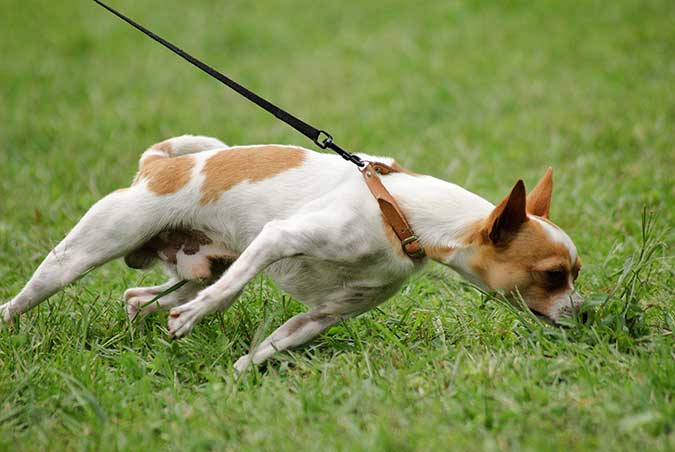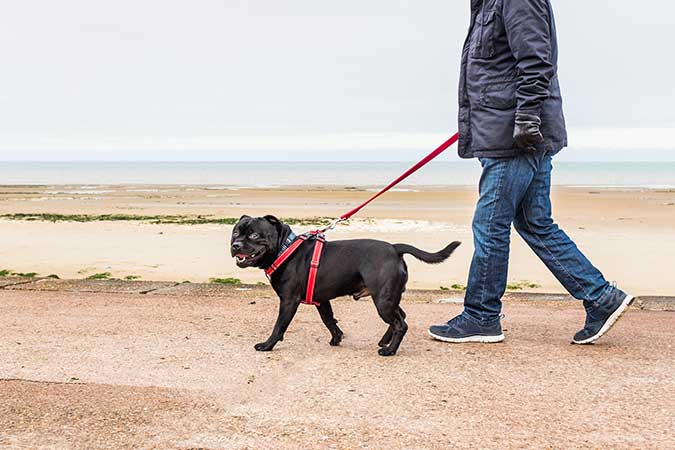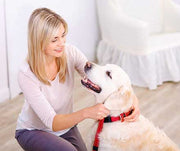Dog Collars Vs. Harnesses

Whether you're stocking up on supplies before bringing a new furry family member home or replacing some worn-out gear that's due for an upgrade, chances are, you'll find yourself deciding on which products are right for your dog.
As pet parents, we understand the importance of daily walks and the consequences of ignoring our dogs' needs for proper exercise and stimulation. When it comes to dog walking supplies, leashes and leads tend to be the star of the show. But there's another star you should be thinking about as well. These are collars or harnesses, which is what your dog's leash or lead attaches to.
Is one option better than the other? What are the benefits and drawbacks of each? Keep reading for the pros and cons of each product, and when we recommend using them.
Differences Between Collars and Harnesses
Collars
Dog collars are one of the most basic and well-known products. When you think of taking your dog out on a walk, you likely picture clipping your leash to the ring of your dog's collar. Simple and to the point, a sturdy, properly fitting dog collar is something every pet parent should have on hand.
Aside from serving as a point for leash attachment, collars are more commonly used for identification purposes. Your dog's collar should have tags displaying the most up-to-date contact information, even if they are microchipped.
Harnesses
A dog harness is an alternative method of hooking your dog up to their leash. The main difference between a collar and a harness is the way in which it's worn. Collars are worn around the dog's neck, while harnesses are strapped around your dog's chest.
The Pros and Cons of Collars
Pros:
- Collars are easier to put on. Most collars just need to be slipped or fastened around your dog's neck. Additionally, collars can be left on at all times, whereas harnesses should be removed after every walk or outing.
- Collars are easier to fit. A majority of the time, a simple neck measurement will give pet parents the information they need to choose the correct size collar. Since harnesses are strapped around your dog's chest, you need to take multiple measurements. Sizes also become less standard the more measurements are taken into account.
- Dog collars have designated places for ID tags, typically a large metal ring.
- There are many different options available. From different colors and patterns to match your dog's personality to reflective and glow in the dark options to increase visibility at night, there's something for every pup.
Cons:

- Collars can be ineffective if too loose. Any slack may give your dog an opportunity to wiggle out and take off. Special consideration must be taken with breeds that tend to have heads smaller than their necks, such as Greyhounds and Whippets.
- Conversely, collars can be painful for your dog if they are too tight. It doesn't require much imagination to realize how a tight collar constantly rubbing against the skin of your dog's neck is a recipe for irritation.
- Regular collars can cause damage to the neck and throat and are not safe for dogs who like to pull. What is your dog's behavior like when you take them out for a walk? If their excitement levels are through the roof and they are constantly pulling against the leash, the pressure of the collar can reduce airflow.
- Collars pose a risk to dogs with certain medical conditions. If your dog has issues such as glaucoma, neck injuries, spinal conditions, or other orthopedic ailments, you should avoid using collars for dog walking purposes.
The Pros and Cons of Harnesses
Pros:

- One of the key benefits of harnesses is that they significantly reduce the pressure on your dog's neck. The harness is spread out over your dog's chest as opposed to being centered on the neck, causing less damage to the trachea.
- Harnesses help to reduce pulling. The harness is dispersed over a larger surface area than a collar, giving you better control over your dog and reducing the risk of injuries.
- Harnesses tend to be a more secure option than dog collars. An ill-fitting dog collar may provide slack, allowing a dog to wiggle free and escape.
Cons:
- Harnesses can be less convenient. While they offer great security than collars, it also means they take more time to fasten. Your dog may get impatient waiting for your to remove it.
- As they cover multiple parts of the body, harnesses can be much more difficult to size. Breed size guidelines may not be accurate. For example, you may have a male Yellow Lab with a chest much smaller than other males of the same breed, or you may have a mixed breed.
- Your harness may not have a designated place for ID tags.
- Harnesses can be uncomfortable. Much bulkier than collars, they can be especially uncomfortable in warmer weather.
The Verdict
We recommend having both a collar and harness on hand. When you use one over the other depends on your dog's behavior and the situation at hand, but generally, we advise the following:
Use a Collar for:
- Regular activities such as lounging around the house or short trips outside.
- Ideally, a collar with tags should be worn by your dog at all times.
Use a Harness for:
- Walks! Unless you've been specifically instructed not to use one by your vet, a properly fitting harness is the most secure option for walking your dog. If you're not up for using a harness for every walk, we recommend using them for longer walks or traveling.
- Harnesses should always be used for walking if you have a dog with spinal problems, orthopedic problems, or have a Brachycephalic breed (such as Pugs or Bulldogs).
Additional Resources:
Previous article

Next article

Related posts
View all-

How to Keep Your Pet Calm During Thanksgiving
Thanksgiving is a time for family, friends, and food, but for our pets, the holiday can be overwhelming. The sudden change in routine, unfamiliar faces and scents, and increased noise can trigger significant stress. Understanding why your pet might feel anxious is the first step toward creating a peaceful holiday experience for everyone, including your furry family members. This guide offers calming tips for pets and practical solutions to ensure your dog or cat feels safe and secure during the festivities.
Read Article -

Top Travel Essentials for Pets This Holiday Season
Holiday travel often means bringing the whole family along, and for many of us, that includes our furry companions. Preparing for holiday pet travel is about more than just packing a bag; it's about ensuring your pet's safety, comfort, and happiness from the moment you leave home until you return. A little planning helps reduce stress for both you and your pet, making the journey a positive experience for everyone involved.
Read Article -

Best Leashes and Collars for Daily Walks: A Pet Parent’s Guide
A daily walk with your dog isn't just a chore—it's a chance to bond, explore, and stay active together. The right leash and collar can make every walk safer and more enjoyable for both of you. With numerous styles and materials available, it's essential to find gear that suits your dog's needs and your lifestyle.
Read Article



